Top Tier CPU Air Coolers Q3 2015: 9-Way Roundup Review
by E. Fylladitakis on July 6, 2015 8:00 AM ESTThe Reeven Okeanos RC-1402
Reeven is a Taiwanese newcomer in the industry. Naturally, most people reading this probably never even heard the company name before today. The company was founded just over a year ago and currently only offers CPU coolers, fans and fan controllers. Reeven sent us their most powerful CPU cooler as well, the Okeanos (RC-1402).
The box that the Reeven comes supplied in is relatively small. Nevertheless, the protection appears adequate, with polyethylene foam protecting the cooler and the bundled items packed inside a cardboard box.
The bundle is a little crudely packed and virtually kept to a minimum. Reeven supplies only the hardware necessary for the mounting of the cooler, a single dose of thermal grease, wire clips for up to three cooling fans, speed reducers for the two provided fans and a leaflet with basic installation instructions.
Reeven supplies two cooling fans alongside with the Okeanos, one 120 mm and one 140 mm fan. Both fans have black frames and genista yellow blades. These are relatively simple models, with sleeve bearings, lacking fancy blades or vibration absorbers. There is one thing of note about these two fans though: they are ridiculously powerful, with the 140 mm and the 120 mm fan rated for a maximum speed of 1700 RPM and 1800 RPM respectively.
The Okeanos is a symmetric dual tower CPU cooler, with strangely narrow towers for its class. Although the difference is very small, the fins of each tower are not precisely geometrically symmetric, with the front side having three small and the rear side one long indentations. The top fin is a 1 mm thick aluminum cover with the company logo punched on it.
The wire fan installation clips do allow moving the front fan upwards in order to gain some RAM clearance - as long as the case is wide enough, of course. Installation-wise, they are a bit of a pain, as Reeven's approach is far too crude, with the wire clips just going straight into the fan holes and clipping onto the side of the fan.
Furthermore, the frame of the 120 mm fan just barely touches the extruded sides of the fins. It is very easy for the 120 mm fan to be installed with only one side on the extruded fins, increasing noise and reducing performance.
Even though the Okeanos initially looks very simple, the bottom of the cooler makes it very interesting. The base is split between a nickel-plated copper lower part and a steel top part, providing mechanical cohesion and retention. In between these two parts, there are six heatpipes, secured with a very generous amount of solder. The two central heatpipes are 8 mm thick, while the other four heatpipes are 6 mm thick, making this the only cooler with an asymmetric heatpipe configuration in our review. The contact surface is well polished and free of imperfections, yet not machined down to a perfect mirror finish.


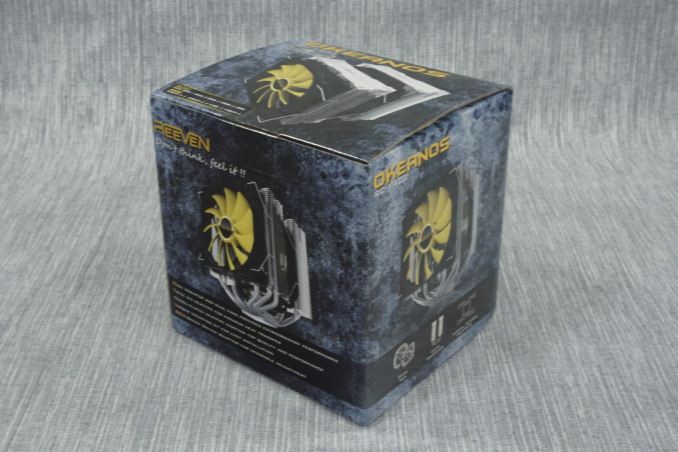
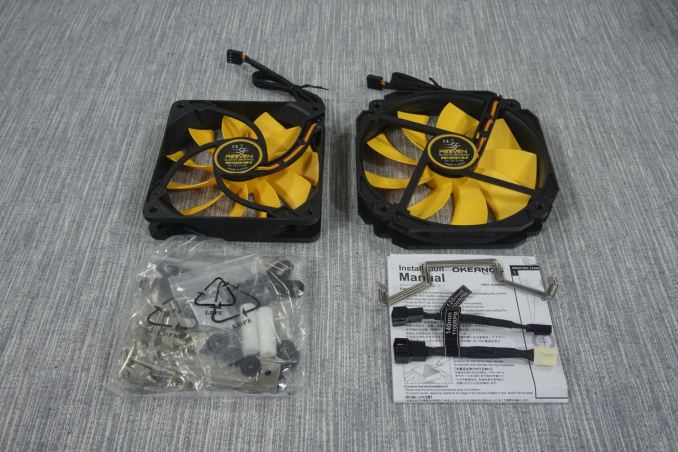
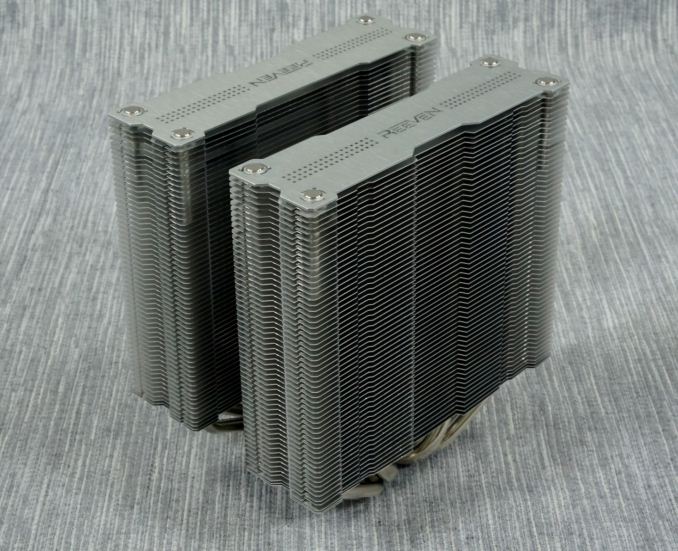
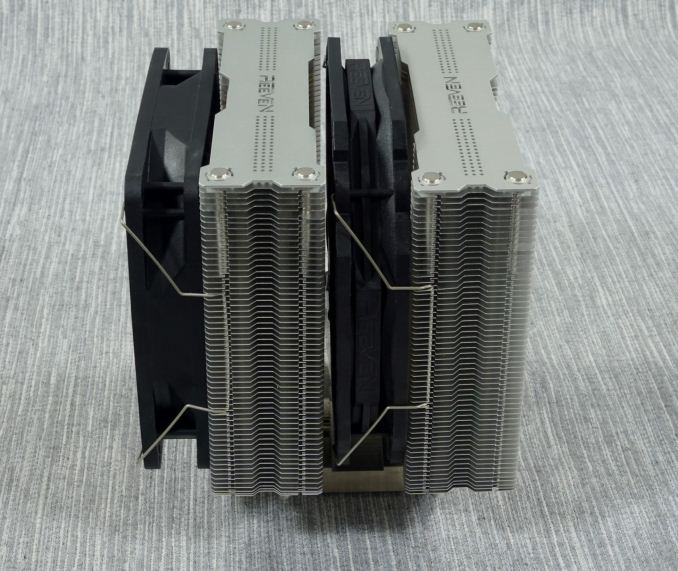
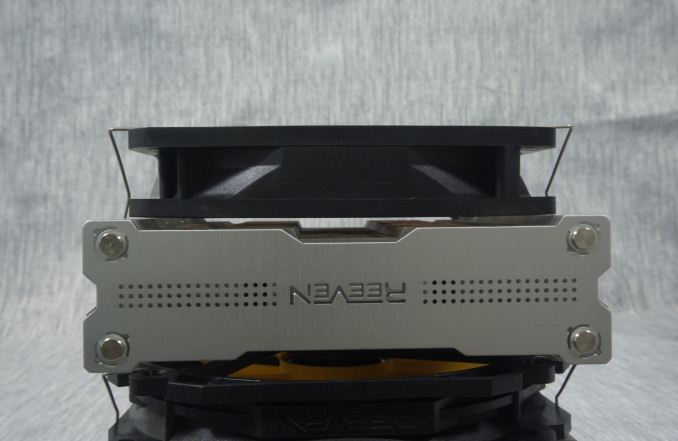
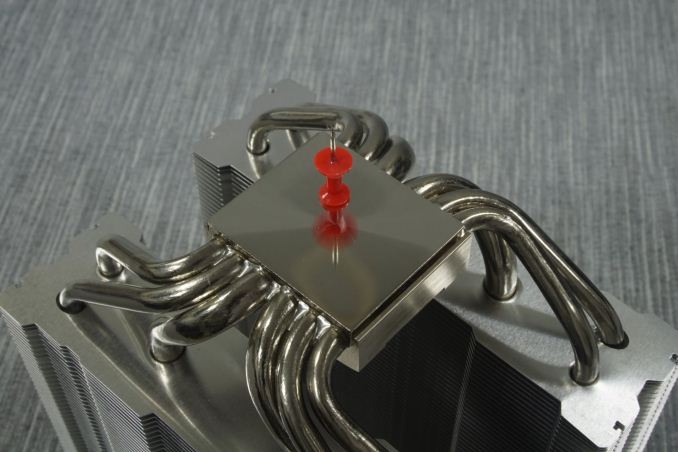








135 Comments
View All Comments
Pissedoffyouth - Monday, July 6, 2015 - link
I wonder how a D15 or similar, with the fans removed, would work with a 45w or 65w APU to make a passively cooled PC.ImSpartacus - Monday, July 6, 2015 - link
That's a really interesting consideration.MrSpadge - Monday, July 6, 2015 - link
This will depend greatly on your case airflow. And if you only run short load bursts (browsing etc.) which can easily be absorbed by the heatsink heat capacity or continous loads (games, work), where the exchange of heat from the heatsink to the outside world limits cooling.iamezza - Tuesday, July 7, 2015 - link
With good fan control you could set the fan to switch off below a certain temp. So it could be silent 99% of the time but with a low rpm fan there if needed.Mumrik - Tuesday, July 7, 2015 - link
You'd probably still need some level of airflow.I've never had a fan on my Scythe Ninja that cools an i5-2500k. I think that's a 95W TDP.
It's close to the single 12cm rear exhaust though.
Beany2013 - Wednesday, July 8, 2015 - link
I did similar with my old SLACR Q6600 95w CPU - Noctua D14 (I think) with a fan on a controller. At stock speeds (with a pair of Noctua case fans on it) it had just enough airflow to run without the CPU fan running at all. When I wanted performance, I could overclock from 2.4ghz to 3.something ghz (I can't remember but I think they went to 3.6ghz?) and just turn the CPU fan up to 'normal' speeds and it'd never get above 70deg and it was still a very quiet machine - HDD noise was far more noticeable than fan noise.I really must get some decent fans for my current rig - a slightly long-in-the-tooth A8-3870 mit 16gb RAM that is still running the OEM cooler. Yes, I've got bored of overclocking. I still have that noctua kit kicking around somewhere, really must dig it out and see if I can get an adapter for it. I'm sure that'll tide me over till we see if Zen is worth a light...?
Essayjedii - Friday, July 10, 2015 - link
I have made a post about D15 in here <a href="http://www.dumblittleman.com/2015/04/14-problems-f... Hope ou find it interesting and useful.Essayjedii - Friday, July 10, 2015 - link
I have made a post about D15 in here http://www.dumblittleman.com/2015/04/14-problems-f...Hope ou find it interesting and useful.
Haravikk - Sunday, July 12, 2015 - link
My current machine is an i7-4790T (45W, 2.7ghz, quad-core, hyper-threaded, 3.9ghz turbo with HD4600 graphics) in an Akasa Euler case, which means the case acts as a heat-sink. As I type this I'm transcoding video on all eight hardware threads with a total load of about 760% (where 800% is max), at a CPU temperature of 85ºC and a clock speed of 2.97ghz.Of course that's for a passive case rather than a heat-sink on its own, but as long as you have somewhere for that heat to go it definitely seems doable. For example if you used an open-air case then ought to just rise out between the heatsink fins so airflow may not be required at all.
Basically keeping the case from becoming a big box of hot air is crucial; the Euler case with my processor (which is a slightly higher TDP than the 35W that the case recommends) gets pretty hot internally, which isn't great for internal drives. I ended up having to swap an mSATA SSD for a 2.5" one, as the mSATA drive just got too hot, while the 2.5" one has a bigger surface area and a metal body. Even so, I squeezed a tiny 40mm fan inside just to help pull hot air out on warmer days.
So ehm… yeah, possible, but you have to be sure you've considered where that heat is going to go before you attempt it. But as others have said; if your case has room then you should just put fans in there anyway and set them to switch off at lower temperatures; you can also use very slow, quiet fans so even if they do run they're silent.
Oxford Guy - Tuesday, July 14, 2015 - link
Stick with a cooler like the NoFan models which are made specifically passive cooling. They will be much more effective.